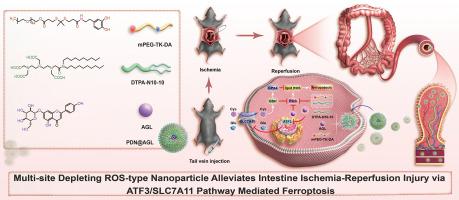Journal of Controlled Release ( IF 10.5 ) Pub Date : 2024-01-02 , DOI: 10.1016/j.jconrel.2023.12.038 Xuerong Zhao 1 , Zhuoya Wang 1 , Guanlin Wu 1 , Lianhong Yin 1 , Lina Xu 1 , Ning Wang 1 , Jinyong Peng 2

|
Intestinal ischemia reperfusion injury (II/R injury) is a common and intractable pathophysiological process in critical patients, for which exploring new treatments and mechanisms is of great importance to improve treatment outcomes. Apigenin-7-O-Glucoside (AGL) is a sugar derivative of apigenin natural product with various pharmacological activities to protect against intestinal diseases. In this study, we synthesized two amphiphilic molecules, namely DTPA-N10–10 and mPEG-TK-DA, which can scavenge free radicals and reactive oxygen species (ROS). They were successfully encapsulated AGL through self-assembly, resulting in the formation of multi-site ROS scavenging nanoparticles called PDN@AGL. In vitro and in vivo experiments demonstrated that PDN@AGL could protect intestinal tissues by reducing lipid peroxidation, lowering ROS levels and inhibiting ferroptosis during II/R injury. Furthermore, our study revealed, for the first time, that the regulation of the ATF3/SLC7A11 pathway by PDN@AGL may play a crucial role in mitigating II/R injury. In conclusion, our study confirmed the beneficial effects of PDN@AGL in combating II/R injury through the ATF3/SLC7A11-mediated regulation of ferroptosis and oxidative stress. These findings lay the groundwork for the potential application of PDN@AGL in the treatment of II/R injury.
中文翻译:

芹菜素 7-葡萄糖苷负载纳米颗粒通过 ATF3/SLC7A11 介导的铁死亡减轻肠道缺血再灌注
肠缺血再灌注损伤(II/R损伤)是危重患者常见且棘手的病理生理过程,探索新的治疗方法和机制对于改善治疗效果具有重要意义。 Apigenin-7-O-Glucoside (AGL) 是芹菜素天然产物的糖衍生物,具有多种药理活性,可预防肠道疾病。在这项研究中,我们合成了两种两亲分子,即DTPA-N10-10和mPEG-TK-DA,它们可以清除自由基和活性氧(ROS)。它们通过自组装成功封装 AGL,形成多位点 ROS 清除纳米颗粒,称为 PDN@AGL。体外和体内实验表明,PDN@AGL可以通过减少脂质过氧化、降低ROS水平和抑制II/R损伤期间的铁死亡来保护肠道组织。此外,我们的研究首次揭示PDN@AGL对ATF3/SLC7A11通路的调节可能在减轻II/R损伤中发挥关键作用。总之,我们的研究证实了 PDN@AGL 通过 ATF3/SLC7A11 介导的铁死亡和氧化应激调节来对抗 II/R 损伤。这些发现为 PDN@AGL 在 II/R 损伤治疗中的潜在应用奠定了基础。































 京公网安备 11010802027423号
京公网安备 11010802027423号